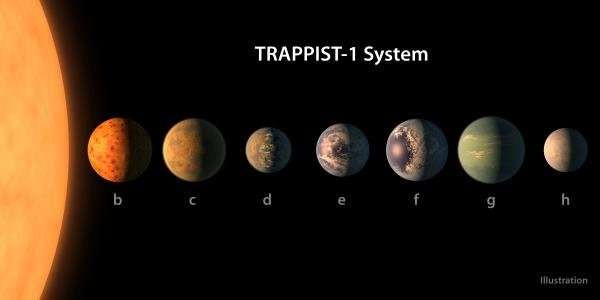The red dwarf star TRAPPIST-1 incorporates the largest number of Earth-sized planets ever discovered outside our Solar System. According to a study recent All of these exoplanets would have remarkably similar densities, providing new clues about their composition.
The discovery of the TRAPPIST-1 system in 2017, only 39 light years from Earth , made headlines. And for good reason:astronomers had described to us a red star surrounded by seven planets so close to each other that you could see them all from the surface of one of these objects. These planets are all the more interesting because they are all rocky. Of the seven, three also evolve in the habitable zone of their star. Thus, one or more of these worlds could, under certain conditions, harbor life, hence our interest.
As early as 2018, astronomers had estimated the masses of these planets. These calculations had then made it possible to determine that all of them were approximately the size and mass of the Earth. Follow-up analyzes with the now-retired Spitzer Space Telescope have allowed planetary masses and diameters to be estimated more accurately. Using this data, the researchers were then able to calculate their density and therefore estimate their composition .
In our own solar system, the densities of the eight planets are highly variable. On one side we have the gas giants, Jupiter, Saturn, Uranus and Neptune, and on the other the four terrestrial planets of Earth, Venus, Mars and Mercury. The former are larger and less dense, being composed mainly of gas, while the latter are smaller and denser.
The seven planets of TRAPPIST-1 all share a similar density , which makes this system very different from ours.

The fact that these planets share a similar density could mean that they all contain roughly the same materials that make up most rocky planets such as iron, oxygen, magnesium and silicon. These worlds, on the other hand, are about 8% less dense than the Earth. This means that their composition must be significantly different.
To explain this lower density, the authors suggest that the TRAPPIST-1 planets have a composition similar to that of Earth, but with a percentage of iron somewhat weaker (about 21% compared to 32% on Earth) . These planets could also have high oxygen levels , forming iron oxide or rust (as on Mars). The extra oxygen would then decrease the density of the planets. It could also be that these slightly lower densities are a combination of these two factors:less iron overall and a little oxidized iron.
This work published in the Planetary Science Journal thus allows us to better characterize these different rocky planets, which will ultimately allow us to estimate their degree of habitability. Our current technical means, however sophisticated they may be, do not allow us to "see" a little further. An instrument could however soon change the situation:the James Webb Telescope, whose launch is scheduled for next October. This highly anticipated observatory could indeed tell us if these planets have atmospheres or not.